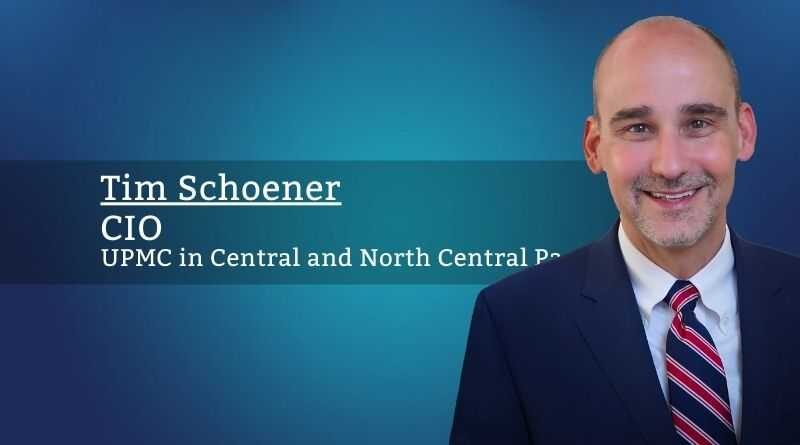Convenience and Choice Critical for Digital Health Strategy
What does your digital front door say about your organization?
By Tim Schoener, CHCIO, MBA, CIO, UPMC in Central and North Central Pa
As expected, the 2021 College of Healthcare Information Management Executives (CHIME) CIO Fall Forum in San Diego did not disappoint. Everyone was talking about digital health and strategy and over one-third of all presentations dealt in some way with digital health and its importance in health care.
This came as no surprise as we are all aware that the pandemic drove many businesses to evaluate their digital strategy, features, and usability. An example that comes to mind for me is Chick-fil-A. I’ve noticed their app, or digital front door, evolved with updates pushed to loyal customers as they responded to customer demand during the pandemic. Their stores were not able to offer indoor dining, yet they overcame, in part, by providing intuitive features designed around their new dining experience.
In their new model, customers can easily pick up their orders without ever leaving the comfort of their vehicles. Customers order from anywhere, either in advance or even on their way to the restaurant. The app uses your phone’s location services so that when you arrive, you’re assigned a numbered designated space to which a worker seamlessly and quickly delivers the food car side. During a year when many restaurants suffered financially, Chick-fil-A increased their revenue by over $500 million and I believe it’s because they were willing to think outside the box and provide the same quality product and experience customers expect in a completely new way.
Unfortunately, many other restaurants did not fare as well. Another example I can recall provided their customers with an app that did not enhance the customer or service delivery experience. The restaurant responded to competitors in the market using similar technology, but their execution fell short. On one occasion, we placed our order and charged it to our credit card only to find out through the app that our wait time for our food would be over three hours. If the point of the app was convenience, then they missed the mark. Operationally, they could not fulfill the customer expectations we had based on the promise their app was promoting. After multiple phone calls, we canceled our order and located some dinner in a much more reasonable timeframe.
According to a company that provides patient engagement solutions, the digital front door is “a strategy for engaging patients at every major touchpoint of the patient journey using technology that patients have already adopted for everyday use.” I appreciate the specific wording of this definition. Successful digital strategists understand that, in part, their success is related to “engaging” their customers “at every major touchpoint” — from the ease of viewing the menu and food selection to payment and pick-up. As the definition also describes, our patients are looking to our digital front door to have the same user-friendly features they have “adopted for everyday use” for other business transactions across many industries.
Our digital front doors should make it as easy as possible for our patients to access quality care while improving the stickiness of our brands.
The health care portal apps that we provide to our patients have come a long way. With the rise and mass adoption of electronic health record systems, many of you may remember the initial meaningful use requirements in which all health care organizations were required to provide a portal for patients to view results, an after-visit summary, and message their providers. Thinking back to 2015, the initial measure stated that at least “one patient must view, download, or transmit to a third party his or her health information.” Talk about a low bar compared to today’s world.
Portals have evolved over the years and now the standard expectation is that patients can refill medications, view and pay a bill, schedule appointments and receive an estimated cost for a test or procedure, view their test results almost immediately following their visit, and even see a provider through a telemedicine visit all in one convenient portal app.
There is a catch though, a proverbial chicken and the egg situation when considering a portal strategy that we as healthcare IT leaders need to navigate. Should we improve our activation rates, or should we provide additional features first to encourage more patients to enroll and use our portals? I believe the answer is both. We need to encourage our patients to enroll, while also simultaneously providing more features quickly and often. We do not have the luxury to single-thread these strategies. We need to be agile, flexible, and adopt and adapt to the needs of our users – our patients – while also navigating the operational challenges of the current healthcare system, such as staffing shortages, increased demand for care, and even broadband connectivity.
If executed properly, an intuitive and comprehensive patient portal app is a wonderful tool. The best patient portals now allow patients to virtually schedule their appointment, check-in as they arrive in the parking lot of the practice, and be self-directed to an exam room without ever being required to visit the front desk. Shortly after completing their visit, the provider’s notes are available in the app as well as any orders placed, test results, and other pertinent information and resources. It’s all there in one convenient location like our patients expect.
These are challenging times, and our digital health strategy plays an integral role in how our organizations continue to provide quality care in the communities we serve. Our digital front doors should make it as easy as possible for our patients while improving the stickiness of our brands. While we, as IT professionals, are not direct clinical care workers, it is our responsibility to listen to our internal and external customers. The technology is at our fingertips to meet our customers’ needs and it’s up to us to be the champion for the role our services play in supporting our organizations’ growth, sustainability, and success into the future.



